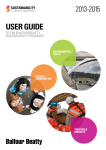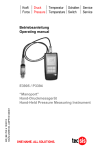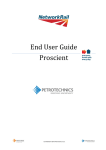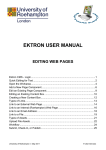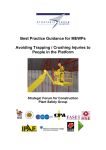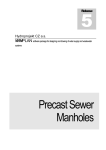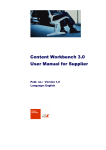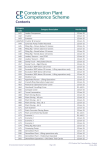Download Plant person interface
Transcript
Safe roads, reliable journeys, informed travellers The Delivery Hub health, safety and environment Raising the bar 3 Plant person interface Issued July 2012, Revised January 2015 An executive agency of the Department for Transport The delivery hub Health, safety and environment - raising the bar 3 Plant person interface - Issued July 2012, Revised January 2015 2 Contents Objective Page 2 Organise Page 3 Lifesaver Page 7 6 Appendix 1 Page 9 << Contents Email: [email protected] The delivery hub Health, safety and environment - raising the bar 3 Plant person interface - Issued July 2012, Revised January 2015 3 Objective Minimum requirements This raising the bar guidance aims to provide advice on minimum and desirable requirements to be taken to ensure the safety of persons in areas where it is necessary to have movement of plant during works delivered for the Highways Agency. The expectation is that all the guidance contained within should be considered as minimum requirements. The following hierarchy of controls should be adopted: Background Plan and design traffic routes to ensure a one-way flow of traffic. Also reduce the need for reversing manoeuvres where possible e.g. drive through loading/ unloading bays. An injury involving being struck by plant is likely to be serious. 15 workers suffered a fatal workplace vehicle injury, in 2012/13 with the highest proportion being in the construction industry. This amounted to around a tenth of the total number of fatal injuries to workers reported to the HSE. Plant / Person interface is recognised as one of the key fatal risks within construction and features in most sites top 5 safety risks. Certainly within highways projects, we have had number of serious accidents and fatalities. In 2010 a vehicle marshall was tragically killed on a Highways Agency Major Project when he was struck by a reversing dozer. This guidance note does not cover interface with public traffic. For information on this topic please refer to either RTB 5 temporary barrier and/or RTB 11 influence driver behaviour. Plan During the initial design stage consider the work process and try to manufacture as much of the construction elements off site to limit the number of plant movements required. A good example of this is on the A453 who have a manufacturing facility based locally who pre-cast sections of the bridges which are then transported to site. The sections are then lifted into place straight from the rear of the delivery vehicle, this reduces the need to off load in a separate storage area minimising the number of vehicle movements. By using BIM for the design process it will ensure you can see how the size of plant will fit and able to operate safely within the area before any commitment needs to be made. As part of the planning process consider removing the human interface required with plant e.g. use of GPS machine control, radio controlled plant, auto feeders on drilling rigs and quick hitches on plant. BIM used to plan interface between plant and persons << Contents Email: [email protected] The delivery hub Health, safety and environment - raising the bar 3 Plant person interface - Issued July 2012, Revised January 2015 4 Organise Every workplace should be organised so that pedestrians and plant can manoeuvre safely. Workplace traffic routes should be suitable for the people and item of plant using them. Where plant and pedestrians use the same traffic route, where possible there should be physical segregation of pedestrians from plant by the use of barriers as well as implementation of normal visual or audible warning materials. Below are some things to consider when organising the workplace: Pedestrian routes Due to the nature of our business and the constantly changing environment in which it is carried out the designation, protection and maintenance of access routes to places of work is an issue that affects all construction / maintenance contracts. Pedestrian access routes include but are not limited to: • Routes from car parks to offices • Routes to welfare facilities • Access into excavations • Access to structures • Routes within buildings or across structures • Routes across working yards or storage areas • Routes to any other area where pedestrians need to access for their work << Contents All pedestrian routes shall be planned to be separated from areas where plant movements are taking place. Pedestrian routes shall be: • Separated from construction plant routes by a physical barrier • Clearly signed, indicating routes, hazards and warnings • Adequately lit • Be a minimum of 1m in width • As direct as possible to the work areas to encourage the right behaviour • Set out to provide early visibility of oncoming construction vehicles. Every crossing must be sited to enable pedestrians to see any vehicle approaching them from a place of safety i.e. they should have good lines of sight. • Separated from reversing areas, loading bays and high risk construction operations. • Maintained in good condition: clear of obstacles, debris, litter, mud, snow and ice • All pedestrian site personnel should be instructed to keep to the pedestrian routes provided. • Consideration should be given to the wearing of Hi-Vis vests or jackets for pedestrians where vehicle routes are busy in areas that are not deemed as construction areas. • Where a pedestrian route needs to cross a traffic route there must be clear signage for drivers. • On larger construction sites and at busy crossing points the use of traffic lights or controlled pedestrian crossings should be considered. • Ensure crossing points are easily identifiable such as the use of red painted hoops over the path at either side of the haul route. Email: [email protected] The delivery hub Health, safety and environment - raising the bar 3 Plant person interface - Issued July 2012, Revised January 2015 5 For works on the highway where it is not practical to establish permanent pedestrian routes, the control and planning of a live works area must include the establishment of agreed pedestrian safe access points, safe passage past the works area and control of pedestrians. Controls must be established in accordance with the Traffic Signs manual chapter 8. This information should be communicated though the induction process and by signage. Vehicle routes Vehicle routes shall be: • Designed to be one way in order to minimise the need for reversing vehicle collisions • Clearly signed, indicating routes, hazards and warnings, speed limits, etc, including road markings where possible. • Be of sufficient size / width / gradient to accommodate the largest required construction vehicle and peak construction vehicle traffic e.g. - Road gradients should be no more than 1:10 - Single track haul roads should be 1½ times the width of the largest vehicle - Two way roads should be 3 times the width of the largest vehicle - Where single track adequate passing bays built in. • Where on the public highway, be designed to ensure members of the public’s vehicles can operate within road width restrictions. • Kept a sufficient distance away from any structure protecting an excavation • Clear of hazards or likely hazards such as scaffolding, refuelling stations and LPG stores. • Maintained in good condition, of an even surface and free of hazards. Where hazards cannot be removed from the vehicle route, they should be signed, barriered and if necessary, lighting provided: << Contents Vehicles / plant Implement a system that assesses site plant / vehicles all round visibility before they are permitted to go out onto the network. In accordance with RTB1 Plant and Equipment, operators of all items of plant should have all round visibility and be able to see at least 1m height and perimeter from machine. A good example of how to check this is to paint a grid on the floor, park the vehicle in the centre and stand in each square to check whether the driver / operator can see the assessor. This can then be transferred to a corresponding grid that can form part of the risk assessment for that vehicle and identify the vehicles blind spot and the controls required for its manoeuvres e.g. vehicle to be fitted with additional devices to give all around vision or to be guided by a suitably qualified person. Email: [email protected] The delivery hub Health, safety and environment - raising the bar 3 Plant person interface - Issued July 2012, Revised January 2015 6 Visibility aids Control Eliminating blind spots and ensuring the plant / vehicle has 360o visibility is preferred. To enhance a plant / vehicles all round visibility there are a number of aids on the market from addition mirrors to sophisticated cameras with 306o view and sensory detectors. As part of the risk assessment and method statement process all mobile plant / equipment will be required to have a Risk / No Risk Zone identified, with the risk zone acting as an exclusion area for all persons. There are even cameras which can determine the human form for other inanimate objects and upon doing so will trigger an alarm in the cab of the plant both on the display unit and also using visual/audible means. The risk zone may cover a single item of plant or multiple items working together and must consider additional risks such as embankments: operating radius, tracking movement and pedestrian zones. The risk zone should be the maximum allowable exclusion zone taking into account the width the traffic management layout will allow. As a minimum the risk zone must be physically segregated by barriers to prevent any persons entering the risk zone. As a minimum the risk zone must be physically segregated by barriers to prevent any persons entering the risk zone. Example of poor working practices << Contents Example of physical segregation Email: [email protected] The delivery hub Health, safety and environment - raising the bar 3 Plant person interface - Issued July 2012, Revised January 2015 7 Lifesaver Where it is not possible to physically segregate persons from entering the risk zone, then an effective control system (e.g. proximity warning technology, mechanical restrictor) must be selected, implemented and established as a minimum around all moving plant. Types of proximity warning systems In deciding which type of proximity warning device is required on a project the following should be considered: • Circumstances of the workplace • Type and quantity of plant in use • Quantity of pedestrian interface • Is a combination of devices required • Where there are multiple subcontractors in one location all proximity warning systems used are to be compatible. Driver warning systems The driver is alerted whenever someone enters the safety zone. Advantages • The driver has the ultimate control of being able to stop the item of plant • Doesn’t always rely on pedestrians wearing a transponder Disadvantages • Single layer of protection • Relies on driver Pedestrians Warning Systems The pedestrian wears a transponder and is alerted whenever they go to close to the item of plant << Contents Advantages • The pedestrian can move into a position of safety Disadvantages • Single layer of protection • The operative cannot stop the plant movement • If a pedestrian without a transponder enters the zone the pedestrian will not be alerted • If the safety zone is set too large relative to where pedestrians need to routinely work, it may continuously cause the alarm to constantly sound causing complacency. Pedestrian and driver combined warning systems Every item of plant is equipped with an active reader, with an adjustable range and each worker wears a tag which communicates with the reader When a worker with the transponder enters the range the reader will trigger the alarm connected to it while the transponder will also sound an alarm thus warning both the operative and the driver Advantages • Double layer of protection • The driver has the control of being able to stop the item of plant • The pedestrians can move into a position of safety Disadvantages • If the safety zone is set too large relative to where pedestrians need to routinely work, it may continuously cause the alarm to constantly sound causing complacency. • If a pedestrian without a transponder enters the zone neither the driver nor the operative will be alerted Email: [email protected] The delivery hub Health, safety and environment - raising the bar 3 Plant person interface - Issued July 2012, Revised January 2015 8 Pedestrian and driver automated systems Plant is isolated / stopped whenever someone enters the safety zone. Advantages • The system is linked to the brakes / isolation system so cuts out immediately removing the need for operator intervention • Good for working under or near overhead services / structures. Disadvantages • Single layer of protection. • Danger of cutting out engine when operator is taking action on the grounds of safety e.g. to stop overturning. A number of different suppliers have trialled a variety of proximity sensors that are on the market and there feedback is offered in Appendix 1. Maintenance, monitoring, risk controls and use A system of monitoring and maintenance for the specific device in place needs to be developed for each scenario however as a minimum: • • • • • Daily plant inspections must incorporate device checks and checked as part of the safety provision and shouldn’t be used if found inoperable. Any transponder issued to an individual should be signed in and out after each shift. Transponders or vehicle devices must be checked prior to issue. A risk assessment needs to cover the range of equipment to be covered, highlight all exemptions and explain the control measures for those exemptions (e.g. chain person is potentially more likely to be run over by the engineers pick up than the excavator). Particularly where the system is warning pedestrians the risk assessment should cover how the system users will be briefed on which equipment on site and if at any time they are not covered by the system to avoid users developing a false sense of security. << Contents • • A risk assessment needs to cover control and maintenance of the system and assign responsibility to specific site staff to police the system. On site plant audits we have found situations where the major components of proximity systems are not functioning and the users of the system who rely on a warning from the primary system have not realised. Audits can be undertaken to analyse the number of breaches that have been committed to see if the original plan and risk assessment is adequate. Communication The Risk Zone exclusion requirements and all pedestrian and vehicle routes must be communicated to everyone on site, including visitors through the relevant induction process. One off delivery drivers / plant operators must receive a specific vehicle movement induction before being allowed onto site. It is of paramount importance that anyone employed or visiting the project is briefed on the Proximity Warning device in use, even if they are not intending to visit or work in the risk zone. As a minimum the proximity warning device in use on the project should be communicated through the following channels: • • • Project inductions should include details of the device and its use. Operatives who have been identified as needing to operate with the proximity device should have a separate briefing on its use and operation Pre-start briefings As a desirable addition, sites should consider awareness workshops that demonstrate the hazards surrounding plant / person interface. A good example of this can be found here http://www.balfourbeattycsuk.com/blogs/news/2013/06/balfourbeatty%E2%80%99s-%E2%80%9Czone-in%E2%80%9D-training-will-help-improvesafety-on-site/#sthash.3R8ZbUMY.dpbs You tube video http://www.youtube.com/watch?v=VODBMHctBx8 Email: [email protected] The delivery hub Health, safety and environment - raising the bar 3 Plant person interface - Issued July 2012, Revised January 2015 9 Appendix 1 - hub review of proximity systems and other controls rev 2. The below is a list of systems trialled by Hub members and is the view of that trial and not the view of the highways Agency. The Highways Agency does not endorse any particular manufacture and this list of suppliers is not exhaustive and other suppliers are available. Ref 1 2.1 2.2 System Trial by Summary Balfour Beatty and Skanska JV M25 Section 1 The system was demonstrated using a dummy mounted on a 250 litre oil drum. The shovel was backed, at some speed, towards the object and successfully came to a halt approx 3 metres from the dummy. Further tests came up with the same results. The operator set the system at the best sensitivity and the machine came to a halt approx 2.5 metres from the dummy. According to McArdles representative, the system had been set up to activate approx 4 metres from an obstruction, which if this is the case, indicates that considering the speed of the machine and the inertia, the system was more than capable of reacting in time. An over reliance on the system could lead to loss of concentration by the driver. No user manual was available in the cab and McArdle do not yet have a program of inspection with regard to this system: something which is required as a matter of urgency. AVM Scene Analysis Balfour Beatty Ground Engineering Three to four cameras mounted around the plant or vehicle. All images joined together by the software to provide an overview bird’s eye view around plant or vehicle. Uses analysis software to alert operator if someone strays into close proximity to the machine. Provides a single point of focus for the operator to see all round the vehicle rather than looking at numerous mirrors, rear cameras and the banksman. • High resolution colour cameras • 160o angle of visibility with one camera • Night vision enabled • Cameras mounted around the plant or vehicle to give 270o or 360o vision • Cameras face down and not prone to glare from the sun • Camera is set for 3m around view of the plant or vehicle • Monitor can switch to full screen when a turn is made • Alarm sounds and red light flashes if movement is detected • 6 hr recording mode is available and is saved on SD card. Manufacturer is working on the software and processor to increase functionality. AVM Bam/Morgan Sindall with Vision techniques New concept which has not yet been proven but Vision Techniques are expecting samples by the end of last year. It comprises of 4 cameras mounted all round the vehicle where the pictures from the camera would overlap. By using special video software the pictures are stitched together to form one easily understood birds eye view around a vehicle so by looking at one monitor rather than 4-5 mirrors a complete overview can be achieved of any dangers around a vehicle. The equipment will also incorporate software that allows you to define a close protection zone around the vehicle and should anybody enter this. Ogden Reversing Radar << Contents Email: [email protected] The delivery hub Health, safety and environment - raising the bar 3 Plant person interface - Issued July 2012, Revised January 2015 10 Ref System Trial by Summary Blaxtair is a camera detection system that is linked to a sophisticated processing unit and software that analyses the objects within the camera’s field of vision using three dimensional images and provides a warning when a human being enters this area. The camera heads consist of two cameras (to give a stereoscopic output) and are positioned by a technician to survey blind spots on the plant. The number and location of camera heads required will be specific to the plant. For example a concrete wagon would typically require one camera head and for an excavator – two camera heads. The outputs from the camera are sent continuously to the processing unit for analysis and then onto the display units mounted in the operators cab. When the processor identifies the human form, an alarm is triggered in the cab of the plant both on the display unit and also using visual/audible means. 3 Blaxtair Balfour Beatty Key features include: Camera head consisting of two cameras – to gain a 3D image Central processing unit Output screens – normally placed in the cab of the plant Warning light and audible alarm - normally placed in the cab of the plant The system has been installed on various machines in the tunnels on C510 and has received good feedback from the plant operators, supervisors and management. Trial Feedback Positives: The big advantage it has when compared to other systems is that it is not reliant on tags or sensors worn by individuals. Negative points / concerns: Cost – circa £11k to protect an R944 Tunnelling excavator. It takes approx 30 seconds to warm up. Early models suffered from electrical surges/dips, but this is now resolved. The camera heads need to be set up by a specialist for each piece of plant. Once in place, daily cleaning of the lens is required. The software is still new and being developed. There are scenarios where the software would not identify the human form, but work is being done with the developers to resolve these. 4 Spillard 3600 cameras Flannery / Morgan Sindall - Pudding Mill Lane, Stratford Crossrail Project Flannery’s fitted Spillard 360o cameras to all excavators on the project over 10t. The clarity of the image is very clear and compared with the alternative system used by our other supplier it is far superior. We do not rely on the device in isolation but prefer to still establish exclusion zones around the excavators. This works well, as it provides the operator with a clearly defined and delineated area under continuous surveillance. Any breach in the exclusion zone prompts the operator to cease any movement. It also allows for ground workers to make ‘first contact’ with the driver without venturing into the danger zone to get eye to eye contact. I am convinced that this type of device will be fitted as standard by machine manufacturers in the not too distant future, and that it plays a significant part in reducing our risk on this project. << Contents Email: [email protected] The delivery hub Health, safety and environment - raising the bar 3 Plant person interface - Issued July 2012, Revised January 2015 11 Ref 5 6 System Spillard Safety Systems - Vehicle Collision Avoidance System (VCAS) sensor Becker mining solutions “Beckercas” Trial by Summary A-Plant / Balfour Beatty - Tottenham Hale Project VCAS is a vehicle safety enhancement system that warns operators of immediate dangers within a predetermined range. The system consists of three sensors mounted on the front of the dumper to monitor obstructions: the sensors send a signal to a control box on the dashboard, which then produces an audible alarm. This provides vital assistance on larger dumpers where visibility immediately in front of the skip is very limited. When mounted on a vehicle in a predetermined configuration a 4 metre primary sensing zone can be achieved, providing effective visual and audible warnings to the vehicle operator. VCAS utilises industrialised ultrasonic technology and cannot be turned off or ignored by operators unfamiliar with its features. Whilst VCAS is an excellent safety device, with Balfour Beatty’s site being near a residential area noise levels needed to be kept ultra-low to avoid disturbance to residents at night. Working with VCAS provider Spillard, A-Plant discussed a number of options to safely modify the audible sensors attached to the dumpers. The solution was to turn the audio warning alarms off at night and fit a warning light as the alert during the night, working on the same principle as the audio sensor would on a 4 metre primary sensor zone. Balfour Beatty The Becker electronics Collision Avoidance system (CAS) provides an early warning indication that brings to his/her attention the presence and the number of personnel and/or vehicles in his vicinity. Using a combination of Vehicle and Control tags, antennas and video equipment Becker Mining solutions have various systems to mitigate a wide range of potential hazards whilst mining. These include: • Vehicle to vehicle awareness • Miner to vehicle to awareness • Hazardous zone awareness • Simple messaging to miner tags • Multimode operation (near and far fields) • Accident investigation support. • Integration with Tagging systems and Communications Networks. • Ability to locate “tags” or equipment. • Learning capability for miner and vehicles working consistently together. Key features include: • RFI Vehicle & Personnel Detection • Integrated High Intensity Audio Alarm • 2 x 7 Segment LCD (Vehicle and Personnel) • System Self Test • Mulitple Antenna types (DPOD ready) • Modular design << Contents Email: [email protected] The delivery hub Health, safety and environment - raising the bar 3 Plant person interface - Issued July 2012, Revised January 2015 12 Pedestrians warning systems Ref 7 System Hazard Avert Trial by Balfour Beatty Summary Creates a magnetic marker field around machinery using a field Generator Installed on the machine. The generator creates low-frequency electromagnetic signals to mark areas consider to be potentially hazardous. The field can encompass the entire machine and its turning radius or be specific to certain areas. Ops wear a personal-alarm devise (PAD) that detects and measures the magnetic marker field and alert them of possible danger to their safety. • HazardAvert Generators can be installed to any/all types of mining machinery and vehicles about and below ground. • Each operative to have an individualised unit • Multiple machines and multiple users can work without conflict • Does not affect environment • Low frequency passes through almost anything including coal, rock, dust and water. • Easily configured • Workers entering and leaving zones and the duration of time spent in the zones are recorded and saved to the TDP data-logger. • Data can be downloaded an analysed. << Contents Email: [email protected] The delivery hub Health, safety and environment - raising the bar 3 Plant person interface - Issued July 2012, Revised January 2015 13 Pedestrians warning systems Ref System Trial by Summary MyZone transmitters are wired into all plant vehicle ignition circuits. My zone starts working automatically with the engine providing warning zones around static and moving hazards. My Zone tags are fitted to the OP’s hard hat. Key features include: • All round 360o safety area capability. • If you leave the safety zone, the receiver gives you a personal reminder when you return. • Can track up to 64 individual threats. • Can be tailor made • Not language specific • Cost effective • Can deliver a safety zone of up to 10 metres around any hazard. 8.1 MyZone Worker Alert System Balfour Beatty Heathrow Trial Feedback BBRCE – positive trial Battery consumption high Personal – doesn’t alert anyone else No feedback on behaviour of operative Positives: System ‘does what it says on the tin.’ Without fail, the units vibrate twice on the users’ helmet headbands when perceived threats enter the operatives work areas, providing a unique jog to the consciousness of the operative. Units (both transmitters & receivers) are well designed and certainly robust enough to cope with the arduous conditions of a heavy civils project. Negatives: Operatives reported that after a few instances of the alert activating, they became irritated by the buzzing on the scalp, one operative comparing it to being prodded in the head. Several of them found the experience annoying and a possible distraction. There appeared to be a general consensus that the unit was uncomfortable whilst attached to the helmet liner even when ‘dormant’. Initially, one or two had not attached the receiver in a sensible position and they were subsequently advised and shown the correct position. Following this adjustment, the complaints nonetheless continued, several complaining that the unit was sometimes impeding the articulation of the neck and head. Conclusions: It could be argued that the location for the trial was the best (and possibly worst) scenario: a lot of plant traffic meaning the units were activating too frequently for personal comfort but equally it could be argued that this is the very reason to trial the kit there. There was positive reluctance to retry the units to ascertain if the irritation/comfort issues would lessen over time. The system may be of more use on live motorway widening where ambient noise is high and the plant traffic more irregular in frequency. << Contents Email: [email protected] The delivery hub Health, safety and environment - raising the bar 3 Plant person interface - Issued July 2012, Revised January 2015 14 Ref System Trial by Summary The A23 Handcross project has since its start in April 2012 has used the personal My Zone proximity alarm to exceptional effect by adding it as part of the 7 piece PPE issue. It has provided this personal alarm to everybody on site, including visitors, thereby increasing everybody’s safety awareness and highlighting the continual workforce engagement that emphasises our sites awareness of the dangers associated with close working adjacent to moving plant. As part of the overall strategy for providing a safe working environment for all, the site management have no doubt in confirming that the use of My Zone on the A23 project has played a vital and essential role in achieving our current safety statistics of 0.00 AFR and 82 weeks and 750,000 hours accident free to date. 8.2 MyZone Worker Alert System Carillion – A23 Handcross – Warninglid Widening Scheme Positives: This system alerts the individual and not the machine operator and therefore called a personal proximity alarm It can be used to emphasise engagement regarding safety on the site Its location on a prominent part of the helmet is fully visible and can be easily identified Issued as part of the induction process we can confirm at a distance that people on site are authorised As part of the helmet it can be issued as PPE emphasising the safety aspects of this device Ease of fitting to plant with magnetic attachments and battery systems Ease of fitting to plant as a fixed item Both transmitters and receivers are weather resistant: we have used them on the A23 for 18 months with no water damage recorded. Transmitters available have a fixed effective range chosen for the piece of plant Very good customer service Negatives: Cost and insistence of supplier regarding hire and not purchase Size of transmitters and need to locate them on the outside of the plant Short battery life for receivers (4 to 6 weeks) and constant need to replace the batteries Effective range is not easy to change requiring transmitter replacement Both transmitters and receivers are made of plastic and have been damaged on site Wire connections would benefit from being more robust. << Contents Email: [email protected] The delivery hub Health, safety and environment - raising the bar 3 Plant person interface - Issued July 2012, Revised January 2015 15 Pedestrian and driver combined warning systems Ref 9.1 9.2 System Ongrade Zonesafe Ongrade Zonesafe Trial by Walters at Costain, Port Talbote Summary Positives: • The system is very robust. The transponders are sealed units and not affected by weather. The antennae unit is very durable. • Larger machines can have more antennae added to give very full coverage of the machine or you can concentrate coverage for a specific area such as the counterweight of the machine. • The plant operator can temporarily silence the alarm but has to continually hold a button to continually silence the alarm. This prevents him from operating the plant machinery at the same time so making pedestrian access to the plant machinery for communication or slinging loads safe. • A-Plant is seriously considering fitting this to all machines – excavators and dumpers – that Costain hire and then selling the transponders as consumables. A lot cheaper than buying the units. • The Transponders work for all sender units so any surviving the end of the contract can be used elsewhere. Also the same transponder will alarm any number of sender units the holder approaches. • Drivers are issued with a transponder thus making two machines capable of `seeing` each other and thus avoid two machines colliding. The system is also designed in such a way that the driver’s transponder will not trigger the alarm while in the machine. Minus side: • Any `rogue` person without a transponder will be subject to a high risk of being struck by machinery if they enter the works area of the machine under the ZoneSafe system as they will not trigger an alarm and the plant operators awareness of them will be limited due to reliance on the ZoneSafe system. • Most people struck by the bucket end of the machine are done so as the machine slews to the right, this is the blind side of the plant operator. In a fairly large machine such as 30t excavator with the bucket at near full reach the bucket might be outside the max zone of the antennae and will put people on the right of the furthest reach of the machine in a potential position of danger with both the pedestrian and plant operator thinking they are safe. • Work where pedestrians work closely with plant machinery such as drainage is going to cause the alarm to constantly go off and will lead to operatives finding ways to circumnavigate the system. • The system is presently relatively expensive. To set up a unit on a fairly big machine such as 20t excavator with 2 or 3 antennae would cost in the region of £4000. That is a big outlay for any subcontractor, and that does not include the transponders - £70 a piece. The price quoted is for individual units, the more you buy, the lower the cost. McArdle – M25 Operatives on the ground have developed a change in culture actively giving plant machinery a wide berth so as not to trigger the alarm. << Contents Email: [email protected] The delivery hub Health, safety and environment - raising the bar 3 Plant person interface - Issued July 2012, Revised January 2015 16 Pedestrian and driver combined warning systems Ref 9.3 System Ongrade Zonesafe Trial by Walters at Costain/ Carillion JV. M1 J10-13 Summary The trial has shown that the existing gated system is proving successful, with the earthworks activities being excluded to other personnel. This can be seen within the recorded data and the non activation of system by the representative transponder carriers as listed above. OnGrade is still relatively new technology that needs further revisions and adaptations to make it work successfully. Revisions required to make the system more successful in operations would be: 1 Location monitor to show where the personnel wearing transponder has breached the exclusion zone. This would allow retrieval of data to indicate possible hot spot intrusions. 2 Increase in radius exclusion zone to 10-12m to allow for rapid movement of reversing plant such as tractor dozers, loading shovels and self propelled/ride on rollers working on formation type activities. 3 The absolute necessity to ensure that every person on site carries a transponder at all times including all site visitors as plant operators would naturally expect the system to be warning them of any unauthorised intrusion. It would be advantageous now to trial the system in a different situation in a more open green field site on an operation utilising different plant e.g. Dozer operations placing Capping or fill materials. 9.4 Ongrade Zonesafe Balfour Beatty M25 S1 Tags are £35 each, lasting 2 years (still to be confirmed). Uniquely tagged. Could be done at daily briefings, Can identify who breaks Safety zone/how often. Can change shape of zone Review by M25 Section 1 – 16th August 2011 Product has been on use on site for approx 6 months with no failure. This product does not currently immobilise the plant, McArdles hope to connect the device to the plant hydraulics sometime in the future, without this the product is only a warning device. This system could be a useful tool in the box, but only where there is a tightly controlled working area and not a location that is open to a variety of user groups i.e. public interface. There is also a possibility that the plant operator could become reliant on the system and not non-tag holders entering the danger areas. 9.6 Ongrade Zonesafe Carillion – M6 J5-8 Birmingham Box Phase 3 Carillion explored the use of zone safe on the Birmingham Box Phase 3 Managed Motorway Project due to the tight and constricted working environment working in just the hard shoulder of a motorway on stilts. A number of meetings and site visits took place but in conclusion it was felt the system was not mature enough for a narrow linear site. A number of improvement suggestions were offered to Ongrade which were taken on board and developed. 9.7 Ongrade – site zone (formally ZoneSafe) Carillion Group From 1st June 2014 – the Carillion group have implemented a hierarchy of control that mandates where a risk zone cannot be physically fenced off then the sites and all its suppliers must implement a proximity warning system. To ensure compatibility Carillion have selected the ongrade site zone system as the main provider for all its projects. << Contents Email: [email protected] The delivery hub Health, safety and environment - raising the bar 3 Plant person interface - Issued July 2012, Revised January 2015 17 Pedestrian and driver automated systems Ref 10 10 7.2 7.3 System ROCS (Remote Operation Cut-off System) Safe working practices Safe Working Practices Safe Working Practices Trial by Balfour Beatty & Skanska – SEESA Tilbury sub station Rouse & Bam/ Morgan Sindall M62 Carillion – A23 Handcross – Warninglid Widening Scheme Carillion Group Summary Ideal product where work area has general public / operatives in close proximity to machine i.e. Roadworks, shuttering, confined or restricted areas. Stops tracks and boom instantly. Kills engine revs. Easy to use by Banksman. When activated, gives audio/visual indication to excavator operator (cab fitted). Colour coded buttons on remote hand held device plus LED. LED flashes once during normal operation or 6 times if battery low charge. Remote clips to Banksman belt and approx weight of mobile phone. Main module sealed and believed to be tamper proof. No restriction on size of machine and has been tested on 2.5 tonne to 22.5 tonne excavators. Excavators are “short radius” or “zero swing”. Short radius excavators vastly reduce and in the case of zero swing eliminate the area where people could be trapped by the side / rear / counter weight of the excavators. Trialling of a speaker system on their excavators, when the excavator is tracked forwards or backwards, the speaker sounds and the words “caution machine in motion“ can be heard. When the switch for the quick hitch is engaged the speaker sounds “Caution stand well clear”. This is audible until the quick hitch cycle is complete and the switch is flicked back to the off position. These speaker systems are retro-fitted to the excavators in K Rouse head office workshop, by their team of technicians. They provide pocket-less hi-viz trousers and long sleeve hi-viz t-shirts for the excavator drivers, to ensure that loose / open pockets from coats or trousers do not catch the joystick controls of the excavator. This has been trialled on a previous site and proved very successful. They have a policy that requires any of their workforce entering the work area to stop the excavator or speak to the operator, then the operator must finish / stop what he is doing, place his bucket on the ground, raise the “dead man” lever in the cab and turn the engine of the excavator off before that person can enter the radius of the excavator. The A23 Handcross to Warninglid scheme introduced an innovative idea to prompt a positive response from plant operators before being allowed to pass. The thumbs up signs are magnetic so that they can be transferred from one piece of kit to another and come in various sizes depending on the item of plant. To make sure plant operators in more isolated areas know when people want to enter their work zone the project came up with an innovative system which uses a wire free door chime, and up to six push buttons. The door chime is placed in the cab of the machine (fits a cup holder), and the push buttons are placed at every entry point to that work zone. To enter the work zone, all that is required is to push the button, and await the driver’s signal to enter. The push buttons have a range of 200m, therefore the attention of the machine operator can be drawn, at a safe distance without the need to enter its working / slewing radius. Initial results are extremely positive from both plant operators and workforce. << Contents Email: [email protected] If you need help using this or any other Highways Agency information, please call 0300 123 5000 and we will assist you. © Crown copyright 2015. You may re-use this information (not including logos) free of charge in any format or medium, under the terms of the Open Government Licence. To view this licence, visit http://www.nationalarchives.gov.uk/doc/open-government-licence/ or write to the Information Policy Team, The National Archives, Kew, London TW9 4DU, or email: [email protected]. This document is also available on our website at www.highways.gov.uk If you have any enquiries about this publication email [email protected] or call 0300 123 5000 Please quote Highways Agency publications code PR83/12 Highways Agency media services Bedford S140682 The delivery hub Health, safety and environment - raising the bar 3 Plant person interface - Version I - Issued July 2012, Revised January 2015




















